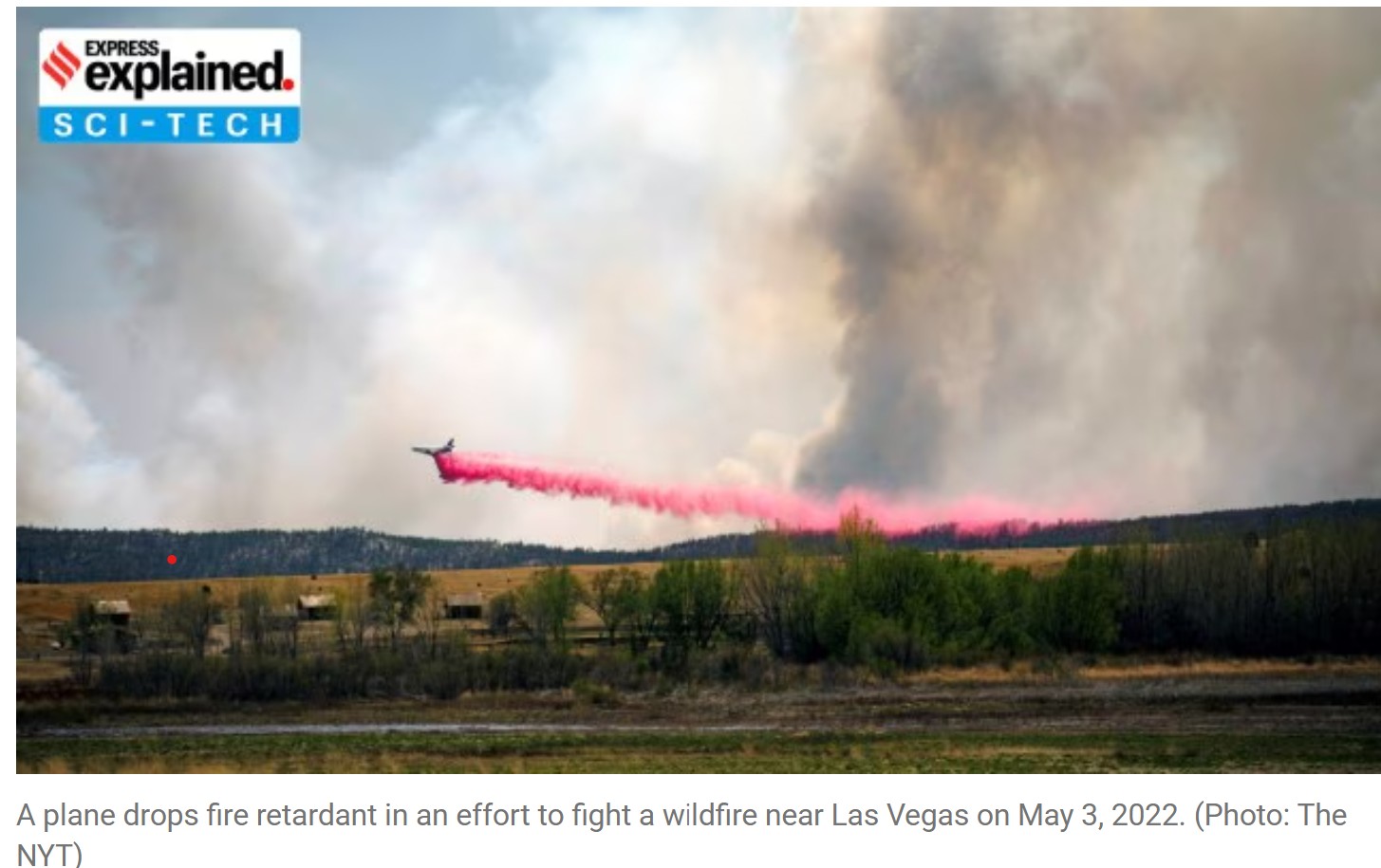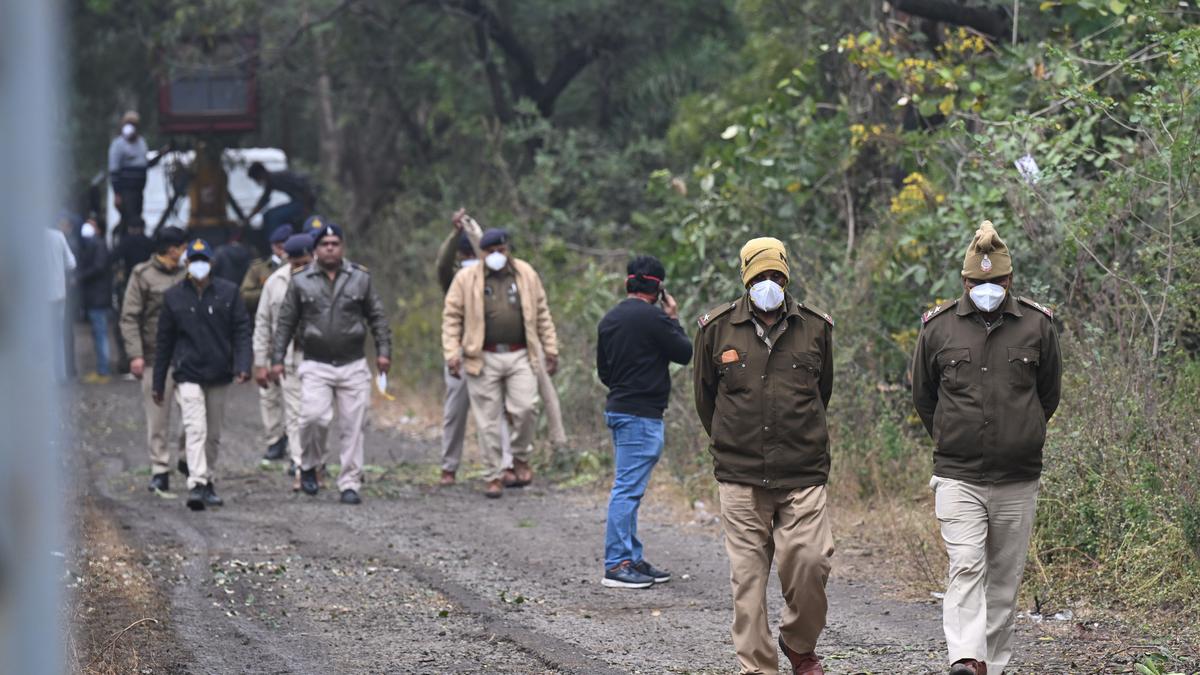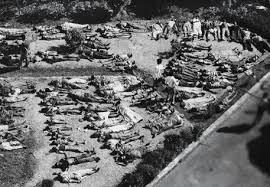Pink Fire Retardant

- 13 Jan 2025
In News:
As wildfires continue to rage across Southern California, authorities are deploying pink fire retardant from aircraft to help combat the blazes. Despite its widespread use, concerns over its effectiveness and environmental risks have surfaced in recent years.
What is Pink Fire Retardant?
- Fire retardant is a chemical mixture designed to slow down or extinguish wildfires. The most commonly used product in the U.S. is Phos-Chek, a brand of retardant.
- Phos-Chek primarily contains ammonium phosphate-based slurry (salts like ammonium polyphosphate), which helps the retardant stay longer and resist evaporation, unlike water.
Purpose and Visibility
- Fire retardants are sprayed ahead of fires to coat vegetation, reducing oxygen and preventing flames from spreading.
- Color is added to the fire retardant, often bright pink, to improve visibility. This ensures firefighters can track its spread and create effective fire lines, helping protect lives and property.
Manufacturer
- Perimeter Solutions manufactures Phos-Chek, which is used for aerial fire suppression efforts.
Effectiveness of Pink Fire Retardant
Limited Effectiveness
- The use of fire retardants like Phos-Chek is not always effective across different wildfire conditions.
- Aerial retardants depend on environmental conditions like terrain, slope, and weather for optimal effectiveness.
- Researchers, including Forest Service scientists, suggest that retardant effectiveness is more limited under changing climate conditions.
- Climate change is narrowing the window of opportunity for using aerial retardants, reducing their impact.
Uncertainty in Impact
- The effectiveness of fire retardants is hard to quantify. Multiple firefighting methods are used simultaneously, making it difficult to attribute wildfire suppression success solely to the retardant.
Environmental Concerns of Pink Fire Retardant
Toxicity and Pollution
- Phos-Chek contains toxic metals such as chromium and cadmium, both of which are harmful to humans and the environment.
- Chromium and cadmium are linked to serious health issues, including cancer and liver/kidney diseases.
- Aquatic life is particularly vulnerable to these toxins, as the chemicals can enter waterways, causing extensive damage to ecosystems.
Impact on Rivers and Streams
- The use of pink fire retardant has raised concerns regarding the contamination of rivers and streams.
- A study by the University of Southern California (USC) in 2024 estimated that 850,000 pounds of toxic chemicals have been released into the environment since 2009 due to fire retardant use.
Growing Use and Pollution
- From 2009 to 2021, over 440 million gallons of retardant were applied across U.S. lands.
- During this period, an estimated 400 tons of heavy metals were introduced into the environment, further exacerbating the pollution levels.
Financial and Practical Concerns
High Cost and Inefficiency
- The cost of deploying fire retardant is significant. Aerial firefighting operations require substantial resources, including planes, helicopters, and large quantities of retardant.
- Environmental experts argue that using fire retardant from planes is ineffective and expensive, especially in light of the growing environmental concerns.
Disposal of Toxic Waste from Union Carbide Factory (Bhopal)

- 07 Jan 2025
In News:
The Madhya Pradesh government has begun disposing of the 337 tonnes of toxic waste from the premises of Union Carbide India Limited (UCIL) in Bhopal, 40 years after the gas tragedy.
Key Highlights:
- Packing and Transportation:
- Waste is packed in airtight containers under the supervision of the Central Pollution Control Board (CPCB) and Madhya Pradesh Pollution Control Board (MPPCB).
- 12 specially designed airtight containers are being used for packing, and each container will be loaded onto trucks for transport.
- The waste movement will be escorted with a green corridor of about 250 kilometers.
- Incineration Process:
- The waste will undergo incineration in Pithampur, with residue stored in a two-layer membrane landfill to prevent contamination.
- A trial incineration of 10 tonnes of the waste was done in 2015 with no harmful effects, and results were submitted to the High Court.
Bhopal Gas Tragedy: A Historical Overview
- About the Tragedy:
- In 1984, a chemical leak at the Union Carbide pesticide plant released methyl isocyanate (MIC), leading to one of the worst industrial disasters in history.
- The leak was caused by a failed maintenance attempt and malfunctioning safety systems.
- Immediate effects included respiratory issues, eye problems, and abdominal pain, while long-term effects included chronic lung conditions, genetic abnormalities, and higher infant mortality rates.
- Legal and Government Response:
- In 1985, the Indian government passed the Bhopal Gas Leak Disaster Act to represent victims in legal claims.
- UCIL initially offered USD 5 million, while the Indian government demanded USD 3.3 billion. The case was settled in 1989 for USD 470 million.
- In 2010, seven Indian nationals were convicted for causing death by negligence, but were released on bail.
Hazardous Waste Management in India
- Definition and Types:
- Hazardous waste refers to waste that poses significant risks due to toxicity, reactivity, or corrosiveness.
- Common sources include chemical production, outdated technologies, and wastewater treatment.
- Regulations and Disposal Methods:
- The Environment Protection Act (1986) and the Basel Convention (1992) govern hazardous waste management in India.
- India generates about 7.66 million tonnes of hazardous waste annually, with the majority being landfillable (44.3%) and recyclable (47.2%).
- Disposal methods include incineration, co-processing in cement plants, and material/energy recovery.
- Challenges in Hazardous Waste Management:
- Inadequate treatment technologies, especially in small and medium industries.
- The need for stricter compliance with waste management laws and more efficient remediation of hazardous sites like Bhopal.
1984 Bhopal disaster

- 04 Dec 2024
In News:
Forty years after the Bhopal disaster on December 2-3, 1984, several hundred tonnes of toxic waste still remain around the ill-fated Union Carbide plant.
Overview of the incident:
The 1984 Bhopal disaster, one of the world’s worst industrial accidents, was caused by the release of methyl isocyanate (MIC) gas, which was a key component in the production of pesticides at the Union Carbide India Limited (UCIL) plant. However, the toxic legacy of the disaster extends far beyond MIC, with a range of other harmful substances lingering in the environment. These include:
- Methyl Isocyanate (MIC):Primary toxic agent: MIC is a highly toxic, volatile compound. Exposure can cause severe respiratory distress, eye irritation, pulmonary edema, and even death.
- Heavy Metals:The site of the plant is contaminated with various heavy metals, including:
- Mercury: Known to accumulate in the body and affect the nervous system, kidneys, and liver. Even small doses over time can lead to chronic health problems.
- Chromium: Exposure to high levels of chromium, particularly hexavalent chromium, is associated with lung cancer and damage to the respiratory system.
- Lead: A potent neurotoxin, lead can cause developmental delays, memory problems, and damage to the kidneys.
- Nickel: Can cause respiratory and lung cancers when inhaled in significant quantities.
- Copper: High levels of copper exposure can damage the liver and kidneys.
- Organic Compounds:Several organic chemicals were found at the site, including:
- Hexachlorobutadiene: A suspected carcinogen that can cause liver damage, kidney damage, and neurological issues upon exposure.
- Chloroform (Trichloromethane): Known for its effects on the central nervous system, exposure can lead to dizziness, loss of consciousness, and even death at high concentrations. It is also a possible carcinogen.
- Carbon Tetrachloride: A potent liver toxin, exposure can result in liver damage, cancer, and nervous system toxicity.
- Trichlorobenzene: These compounds are volatile and can spread through air and water, accumulating in fatty tissues and causing damage to organs like the liver and kidneys.
- Persistent Organic Pollutants (POPs):Some of the contaminants, particularly the organic compounds, are classified as persistent organic pollutants, which do not degrade easily in the environment. These can lead to:
- Cancer: Several of these compounds are carcinogenic.
- Neurological damage: Prolonged exposure can affect both the central and peripheral nervous systems.
- Reproductive and developmental disorders: Exposure has been linked to adverse effects on fertility and developmental health in humans.
- Environmental and Long-term Health Effects:
- Even decades later, contamination continues to affect the health of people living around the site, with high rates of cancers, birth defects, respiratory diseases, and other health issues. Water sources in the region remain unsafe due to heavy contamination with toxic chemicals. Persistent organic pollutants have been identified in local communities, indicating that the contamination continues to spread.
Asia-Oceania Meteorological Satellite Users' Conference (AOMSUC-14)

- 02 Dec 2024
In News:
The 14th Asia-Oceania Meteorological Satellite Users' Conference (AOMSUC-14)was held in New Delhi, India, hosted by the India Meteorological Department (IMD) under the Ministry of Earth Sciences. This annual event brings together meteorologists, earth scientists, and satellite data users to discuss advancements in satellite technology for weather and climate monitoring.
Key Facts:
- Objective:
- Promote Satellite Observations: Highlight the importance of satellite data for meteorology and climatology.
- Advance Remote Sensing Science: Foster advancements in satellite technology and its application in weather forecasting and climate monitoring.
- Encourage Collaboration: Facilitate dialogue between satellite operators and users to enhance the use of satellite data across the Asia-Oceania region.
- Discuss Future Plans: Update on the current status and future plans of international space programs.
- Engage Young Scientists: Encourage the involvement of young researchers in satellite science and meteorology.
- Participants:
- Around 150 participants from various countries, including key international space organizations like WMO, NASA, ESA, JAXA, and other meteorological and space entities.
- The conference will feature oral presentations, poster sessions, panel discussions, and a training workshop focused on satellite data application.
- Significance of the Conference:
- Regional Cooperation: AOMSUC promotes stronger cooperation between countries in the Asia-Oceania region, addressing shared challenges in meteorology and satellite data usage.
- Improved Forecasting: Enhances satellite data utilization for more accurate weather forecasting, disaster prediction, and climate monitoring.
- Disaster Risk Management: Strengthens early warning systems for extreme weather events, improving disaster preparedness and response.
- Capacity Building: Offers training and workshops for local meteorologists, boosting the capacity of countries to use satellite data effectively for weather forecasting and climate services.
- Data Sharing: Encourages collaboration in satellite data sharing, facilitating better access to meteorological data across national borders.
- History of AOMSUC:The first AOMSUC was held in Beijing, China in 2010. Since then, the conference has been held annually in various Asia-Oceania locations and has become a leading event for the meteorological community.
SanyuktVimochan 2024

- 20 Nov 2024
In News:
Recently, the Indian Army successfully conducted the Multilateral Annual Joint Humanitarian Assistance and Disaster Relief (HADR) Exercise, 'SanyuktVimochan 2024' at Ahmedabad and Porbandar, Gujarat.
Key Highlights:
- Conducted by: Konark Corps of Southern Command, Indian Army.
- Day 1: Tabletop Exercise (TTX)
- Theme: 'Cyclone in Coastal Region of Gujarat'.
- Focused on simulating a cyclone scenario affecting the Okha-Porbandar coastline.
- Discussed disaster relief strategies and interagency cooperation to improve response readiness.
- Attended by senior officials from NDMA, Armed Forces, State Disaster Management, and industry representatives, including delegates from nine foreign countries.
- Day 2: Multi-Agency Capability Demonstration
- Held at Chowpatty Beach, Porbandar.
- Simulated Disaster Scenario: Coordinated response to a cyclone, showcasing joint operations by:
- Indian Army, Navy, Air Force, Coast Guard, NDRF, SDRF, and other Central and State agencies.
- Key actions demonstrated:
- Requisition and Surveillance: Civil administration’s request for Armed Forces' assistance, followed by area surveillance.
- Rescue Operations: Insertion of personnel to rescue casualties.
- Casualty Evacuation: Use of resources to evacuate and assist victims.
- Resuscitation and Rehabilitation: Restoration efforts for affected citizens.
- Industrial Display &Atmanirbhar Bharat Initiative:
- Showcased indigenous HADR equipment from Indian defense industries.
- Highlighted technological advancements and self-reliance in disaster management.
- SanyuktVimochan 2024 enhanced India's disaster response capabilities, ensuring a coordinated and effective approach to humanitarian assistance.
- The exercise also bolstered India’s leadership in global disaster relief, contributing to international best practices and collaborative efforts in humanitarian assistance and disaster response.
